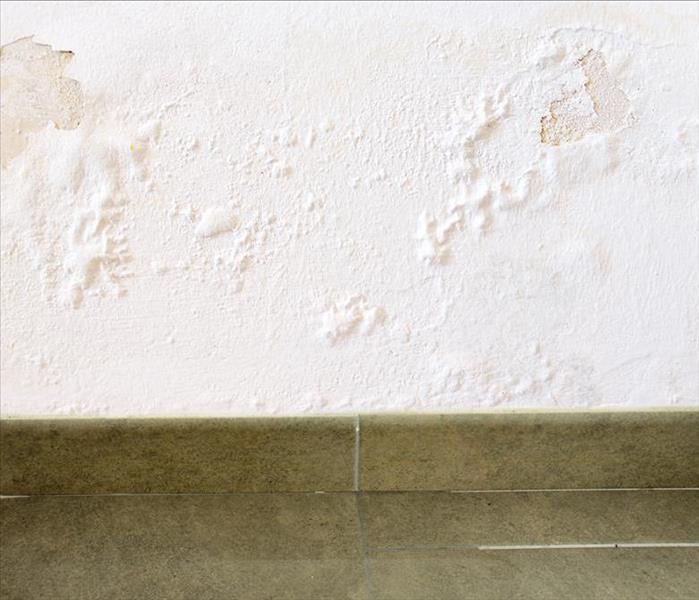Condensation on Your Walls and What it Means
5/17/2021 (Permalink)
 Condensation and moisture on your wall can lead to paint damage, sheetrock damage, and in many cases, mold growth.
Condensation and moisture on your wall can lead to paint damage, sheetrock damage, and in many cases, mold growth.
If there is condensation on your walls, you should do something about it. It may look harmless, but it is dangerous in the long run. Wet walls are a suitable habitat for mold and mildew, which can cause health effects. In addition to that, your walls may get too weak and collapse with time.
Signs of Wet Walls
There are various things you will spot if your walls are damp. For instance, you may encounter some damp, musty odor every time you walk into a room, and yet there is nothing damp in the room. There may also be dark marks on a wall, and the plaster looks discolored. Additionally, you may notice that your wallpaper or paint is peeling off.
Causes
The leading cause of wet walls is condensation. Other causes are leaks and drainage, and damp issues. Below is a breakdown of the causes and what to do about each of them.
Condensation
Condensation appears on your wall when excessive hot air in the house settles on the cold walls and cools, thus turning into water. Excessive air often results from cooking or the shower.
You can employ the following remedies for condensation:
Have An Exhaust System
Install an exhaust system in your kitchen and bathroom to suck out the steam instead of having it waft around the house. You can also ensure you close the door and keep the windows open while showering or cooking. Ensure you cover the pots and pans as the food cooks to prevent too much steam from escaping in the kitchen.
Have A Proper Ventilation System
You need to ensure that there is as much breathing space as possible in your house. This can be as simple as committing to open the windows as often as possible so that hot air goes outside instead of settling on the walls.
Invest In a Dehumidifier
This is a machine that sucks excess moisture out of an enclosed area. It will be a great addition to your home to aid in fighting condensation.
Keep Your House Warm
Try as much as possible to ensure your house is warm. This way, the walls won’t turn cold, and there will be no place for air to condense. Turn on your heating system at regular intervals and keep the fireplace burning if possible.
Hang Your Clothes Outside
When you do your laundry and put it to dry in the house, they release the moisture into the house, and it will inevitably land on the walls. Air it outside instead. If that is not possible, get a tumble dryer or place a humidifier close to the clothes to absorb the moisture. Note that if you choose to get a tumble dryer, you will need to install an external ventilator or get one that is self-condensing.
Leaks
Apart from condensation, leaks can also make your walls wet. These leaks can result from faulty pipes, either due to wear and tear or poor installation. The leaks can also be from the roof because of broken tiles. The water from these places slowly seeps into the wall. Gradually, you will start noticing the signs of dampness on the wall.
The best way to deal with this is to schedule an inspection to identify the source of the leak. Once you figure that out, contact a professional to fix the issue as soon as possible. It is advisable always to inspect your roof for leaks at least twice a year to avoid the risk of water damage. When you ignore leaks, they may cause damage that will cost you more than you would have spent on repair.
Rising and Penetrating Damp
Rising damp is where water seeps into a wall from the bottom. Penetrating damp, on the other hand, is where it seeps into a wall from any source. This can even be a result of a leak. For rising damp, the most effective solution is to fix your drainage system so that water does not come into contact with your walls. You also need to repair the damages brought about by the damp and work on your ventilation.
More Helpful Tips
To prevent condensation, you can also ensure your gutter and downspout system is in perfect condition. Apart from that, if you have lots of houseplants, consider taking a few of them outside. Plants also release moist air, and too much of it may exacerbate your condensation issue.
If the condensation on your walls has already caused molds to grow, get rid of the molds by using mold spray, wiping them down with a wet cloth, or one steeped in diluted bleach. Before you repaint or install new wallpaper, ensure you have completely gotten rid of the wetness on your wall.
Always engage a qualified professional to help you determine the extent of your problem and suggest the best course of action to take.
Conclusion
Because wet walls can result from many different things, be sure to establish the cause before choosing a remedy. Otherwise, you run the risk of fixing the wrong thing, and the problem will keep recurring. Note that it is always best to prevent something than to fix it. So even if you aren’t dealing with condensation yet, you can always put in measures to ensure it does not come up. For more information on condensation and how to deal with it contact SERVPRO of Winter Park.





 24/7 Emergency Service
24/7 Emergency Service